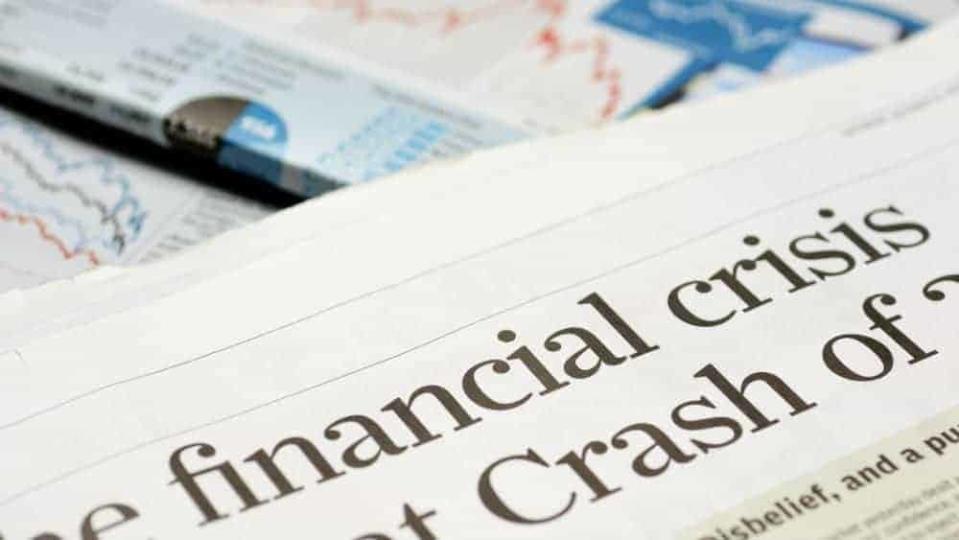WARNING: This $10 Trillion Powder Keg Could Crash the Stock Market!

In 2019, North American markets went on an epic bull run, reaching all-time highs and posting their best returns in years.
In the years ahead, it could all come crashing down. That’s according to hedge fund kingpin Jim Rogers, a former George Soros associate who helped launch one of the most successful funds in history.
Rogers has identified a $10 trillion “ticking time bomb” that could have severe implications for North American markets. While this growing threat is largely coming out of the U.S., there are parallels in Canada — including a $100 billion problem of our own that mirrors what’s happening south of the border.
U.S. corporate debt is reaching frightening heights
According to the U.S. Federal Reserve, the total level of U.S. corporate debt had reached $9.973 trillion in November of 2019. This figure represents a 50% increase above the levels of debt observed during the financial crisis.
Further, corporate debt now represents 47% of the entire U.S. economy — an all-time high. In a recent interview, Rogers said, “we’re going to have a horrible time when this comes to an end.” He’s speaking about the entire world, not just the U.S.
It will have a massive effect on the Canadian markets
It would be naïve to think that a corporate debt bubble in the U.S. would not affect Canadian markets. The U.S. is Canada’s largest trading partner, accounting for about three-quarters of Canada’s total exports. In 2018, Canada exported $337 billion worth of goods to the U.S. out of $450 billion in total exports.
Obviously, a corporate debt implosion in the U.S. will have a major impact on the Canadian economy and, most likely, a slackening of demand for export goods. Further, the U.S. corporate debt bubble mirrors domestic Canadian trends, such as a massive increase in credit card debt, which recently reached an all-time high of $100 billion.
What to do
In an environment where corporate debt is reaching dangerous levels, it’s best to avoid shares in over-leveraged companies. There are two reasons for this:
Companies with high debt levels often depend on borrowing to grow, and declining credit ratings plus bank wariness could make it harder to borrow.
Overly indebted companies may have a hard time paying back principal on bonds when they mature.
For this reason, commodities can be great investments during debt bubbles, as their value isn’t tied to corporate finance.
Another asset class worth considering is stock in companies with low debt levels. Such companies would be less affected by a debt bubble, since their financing comes from non-debt sources.
One example of such a company trading on the TSX is Shopify (TSX:SHOP)(NYSE:SHOP). As of its most recent earnings release, it had no long-term debt and a manageable amount of current liabilities.
Shopify has raised money in the past primarily by selling stock. This has raised concerns about equity dilution but left the company with a relatively debt-free balance sheet.
That lack of debt doesn’t appear to have hurt the company’s growth, either. In its most recent quarter, Shopify grew earnings at 45% year over year, with even more impressive gains seen in some individual business segments. In the past, Shopify’s growth was even stronger than that, but 45% is still one of the best revenue-growth rates among TSX tech stocks.
Of course, a high-growth stock like Shopify should be only one component of a balanced portfolio. It does face its own risk factors, such as a nosebleed valuation and the aforementioned revenue deceleration. Nevertheless, it could make a solid addition to a balanced portfolio of equities that aren’t too exposed to corporate debt, along with some commodities and non-traditional assets.
More reading
Canada Revenue Agency: 1 Big Change to Watch Out for in 2020
CPP Pension Users: Is 60 or 70 the Ideal Age to Take Your CPP?
Fool contributor Andrew Button has no position in any of the stocks mentioned. Tom Gardner owns shares of Shopify. The Motley Fool owns shares of and recommends Shopify and Shopify.
The Motley Fool’s purpose is to help the world invest, better. Click here now for your free subscription to Take Stock, The Motley Fool Canada’s free investing newsletter. Packed with stock ideas and investing advice, it is essential reading for anyone looking to build and grow their wealth in the years ahead. Motley Fool Canada 2020

 Yahoo Finance
Yahoo Finance 